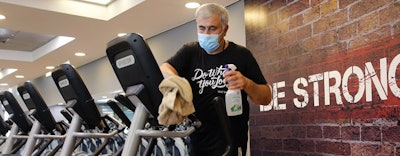
If any positives can emerge from a pandemic, one might be the further realization of just how important the athletics, fitness and recreation industries are to our collective physical and mental wellbeing. Most professionals were more than willing to shutter their storefronts and sacrifice entire playing seasons as the nation came to grips with COVID-19, but there's no denying the deep sense of loss inherent to that process — feelings exacerbated by the months of forced inactivity and isolation that followed.
It's no wonder the desire to get back to business is so strong.
Now comes the challenging work of reopening. With renewed commitment to customer service and care, industry leaders are re-examining the operational status quo like never before — and finding safer ways to deliver the most coveted of end products: good health.
These pages represent an overview of progress being made by organizations and individuals alike during this unpredictable period of transition in athletics, fitness and recreation.
—The Editors
Stanford University is on one side of the reopening conversation, admits Alex Accetta, executive director of Stanford Recreation and Wellness — the side of extreme caution.
RELATED: How Aquatics Centers Are Reopening Amid the COVID-19 Pandemic
From his vantage point in already cautious California (the Cal State University system is continuing virtual classes into the fall), Accetta is aware of schools across the country planning to reopen in a business-as-usual fashion, schools that are reopening their campuses with limited residential life (no roommates, for example) and schools that are reopening their campuses with no residential life at all. "If it's a residential campus and people aren't there, it will hurt," he says, adding, "A lot of schools are commuter schools. People will still come — they just won't have the numbers, so they probably won't be able to do as much programming. It's a big ripple effect."
RELATED: Colleges take phased approach to athletes’ return
As Accetta eyes a late-September start of a new academic year, he admits that surrounding Santa Clara County (as of late May, at least) isn't "too far along" in its own reopening process. His hope for Stanford, a private school not affiliated with the CSU system, is to handle change while minimizing impact on end-users. "The rec world will just look smaller," he says. "Maybe we're going to offer four different yoga classes in four different rooms at 30 percent capacity, but Wednesday will be yoga day. And then the next day will be light bootcamp day. I don't know. People in sports and recreation are pretty innovative, and I think you'll just see it look slightly different, and I think you'll see regional and local differences."
RELATED: High Schools coordinate complicated reopening plans
By late May, Stanford Rec's seven-phase reopening plan themed around the trademark Stanford tree had begun to take shape. The draft form includes a planting phase of preparing facilities and staff, a seeding phase of establishing hygiene protocols and revising programs, a tree phase of reducing class sizes and refining sanitation, a wood phase of expanding group fitness and reintroducing day trips, a forest phase of more normal-size classes including a reintroduction of cycling, a Cardinal phase establishing a new normal of social distancing and patron access to sanitation and, finally, a forest fire stage with contingencies for a coronavirus resurgence, including the potential return to earlier phases. (The working document, more detailed than described here, is subject to change.)
RELATED: Fitness Clubs exceed reopening expectations
"We're seeing the conversation shift now to personal responsibility and a little bit of what I would call risk acceptance," says Accetta, noting that Stanford recreation staff will nonetheless don masks and stand behind countertop shields. There will be increased signage in facilities and "all sorts of education," he says. "We've even talked about making patrons do an online training before they come in. 'Hey, you need to agree that you're going to clean the machines. You need to know what 6 feet looks like. You need to know what wearing a mask looks like, so that we have agreement and you're not going to yell at our staff when they ask you to do something to keep people healthy.' "
RELATED: Public Parks and Rec resumes serving diverse populations
One of the factors Accetta will monitor most closely is spatial relationships. Cardio equipment will be moved from studios into gyms, with 10 or 12 feet between exercisers. "It's a function of time and proximity and the amount of exhalation," he says, pointing to how an hours-long church choir practice led to an outbreak in Washington state. "To me, that says we should limit the amount of time that people can be in our spaces — an hour and a half or an hour, whatever we decide, have them leave for half an hour, let the HVAC do the best that it can, and then let a new group of people come in. That's on the far end of the spectrum of caution."
RELATED: Reopening: Products
But he's making no apologies. "We might be overreacting. I don't know. The data is all over the map," Accetta says. "I think at Stanford, for me to open, that's the standard I'm going to have to meet. My goal is to get open. If I put something forth to my university and my protocols aren't on the more cautious side, then I'm maybe not going to be allowed to open. I'm going to open on the cautious side, because people want to come back."
This article originally appeared in the July | August 2020 issue of Athletic Business with the title "College Rec balances caution, desire to return." Athletic Business is a free magazine for professionals in the athletic, fitness and recreation industry. Click here to subscribe.





































